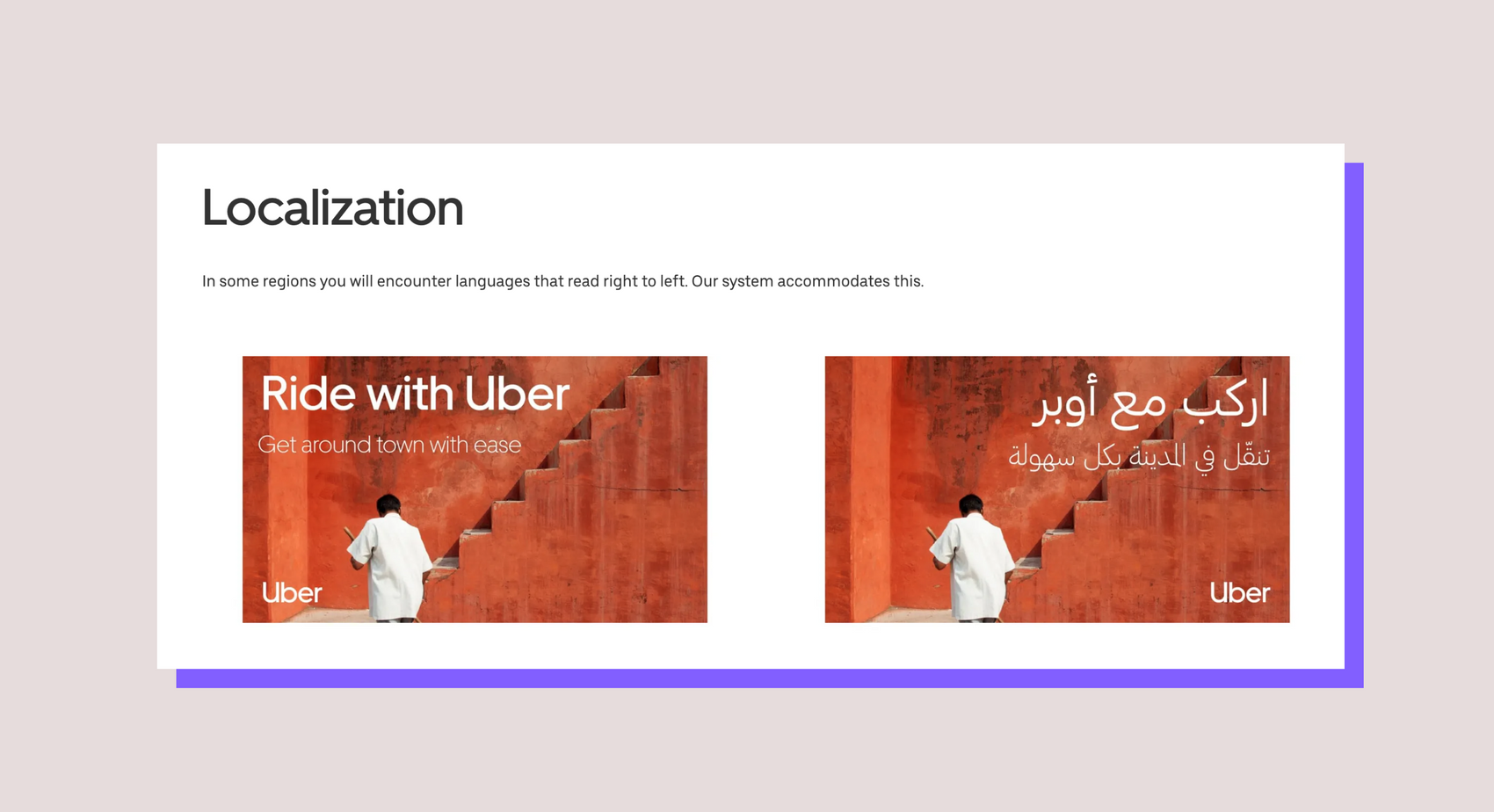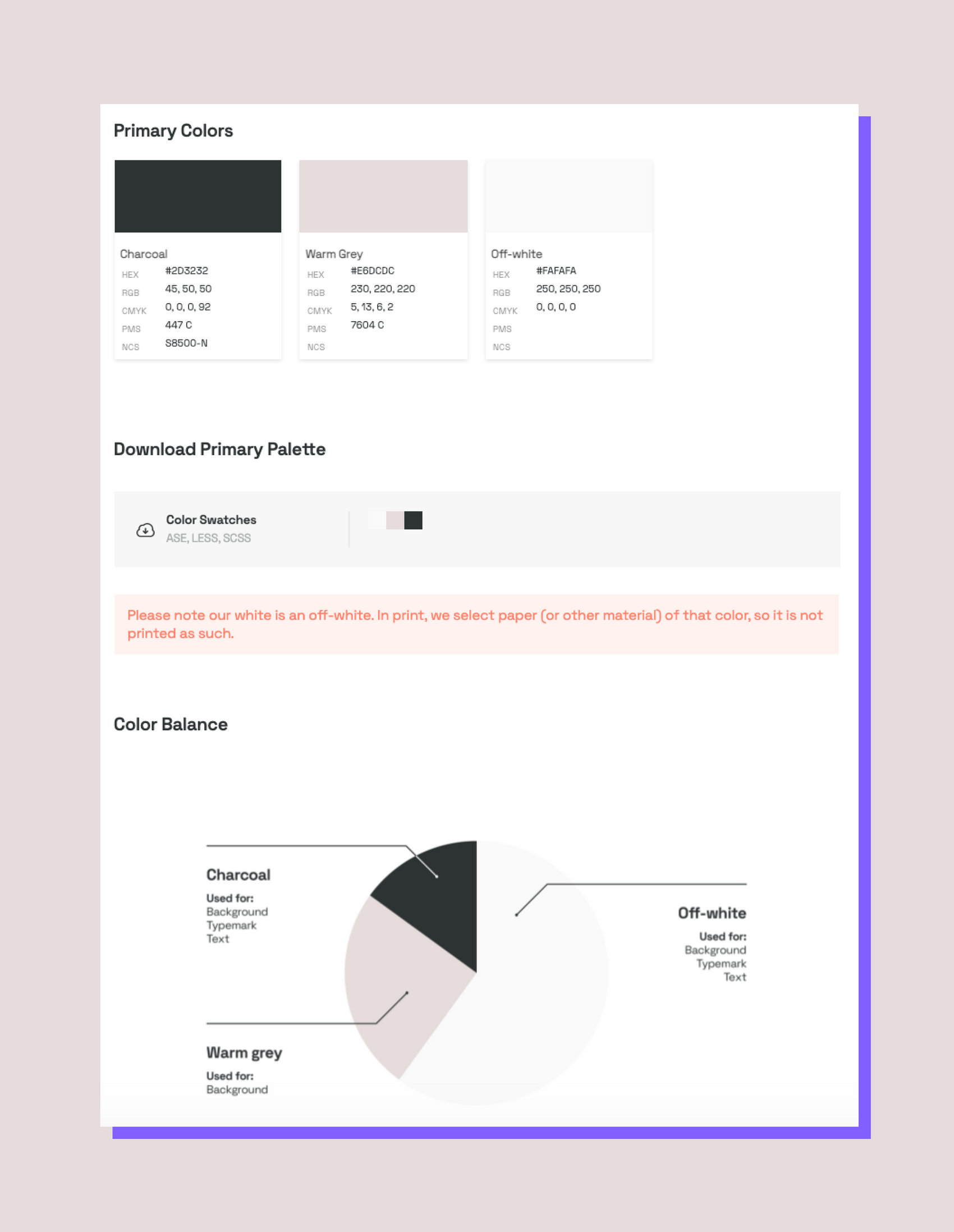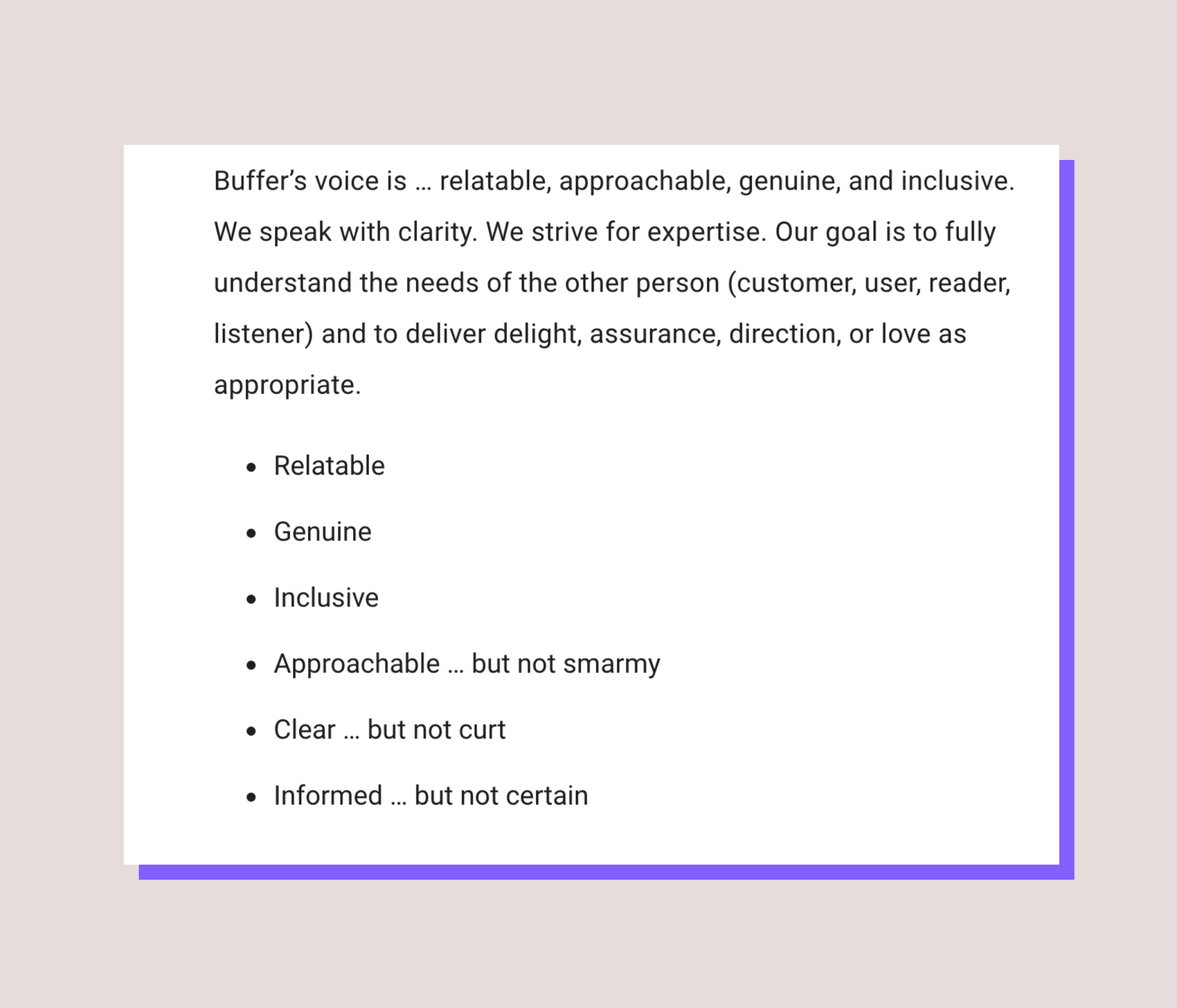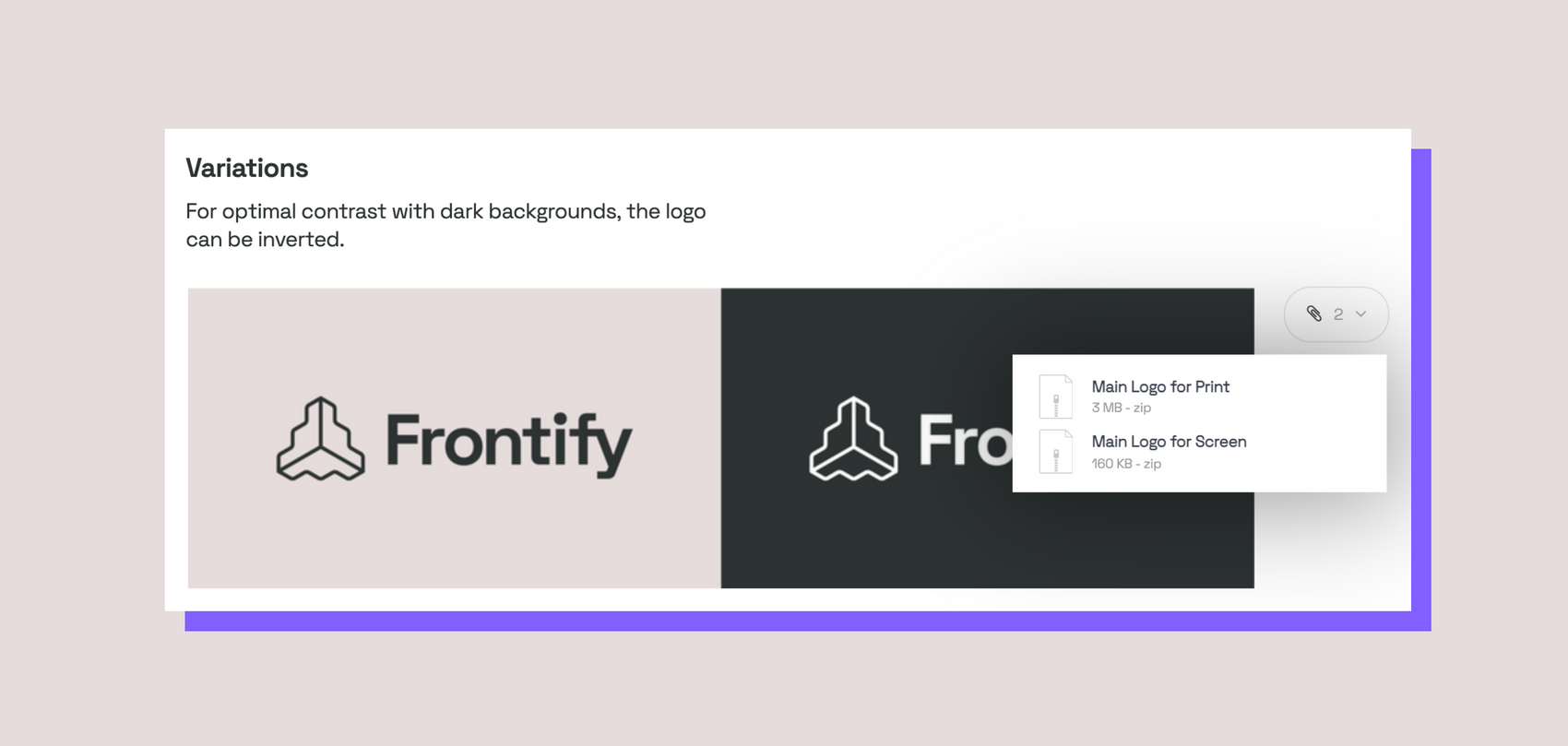To build a strong, recognizable brand, you need everyone in your business to present a consistent brand identity to your customers and the wider market. But our State of Brand Ownership Report found that, when it comes to creating off-brand materials, the worst offenders were the teams you’d expect to be most invested in your brand: C-level executives and marketing departments.
We also found that 67% of respondents use creative guidelines that aren’t part of the company’s official brand guidelines. This suggests that two-thirds of companies have guidelines that don’t work for their business and aren’t being used properly by their employees.
Companies need to develop comprehensive brand guidelines to improve the consistency of their visual and written content. Consistency makes the company look more professional and is essential for building and maintaining brand recognition.
What are brand guidelines?
Brand guidelines are where you document and share the rules, standards, and instructions for bringing your brand identity to life. They help companies achieve consistency by documenting how your brand should look, act, and sound. They document your company’s mission statement and core values and explain how to use visual and written elements to express your brand identity and values in your content.
Many companies initially document their brand guidelines in PDFs. However, as the company grows and its brand evolves, employees find it hard to maintain and update the files and ensure everyone is working from the latest version.
When branding becomes a priority for these companies, they often switch to an online platform like Frontify to host their brand guidelines instead. This is because online brand guidelines are more flexible than PDFs and are easier to maintain. Because online brand guidelines are a centralized home for your brand, when you make a change, it’s automatically reflected for all employees, so everyone always has access to your up-to-date guidelines.
Why are brand guidelines important?
Brand guidelines help engage people with your brand by defining and documenting what your brand means. They turn “brand” from an abstract concept into something concrete each team and employee can understand and apply in their daily work. Brand guidelines are important because they:
- Boost internal brand engagement. Everyone on your team can access and use your brand guidelines, not just your creative teams. This gives all your employees a greater sense of ownership over your brand, as it gives them the ability to create on-brand messages, designs, and customer experiences without having to run everything past your brand manager.
- Improve consistency. Brand guidelines explain and demonstrate how to use the different elements of your brand identity to create content, messaging, and designs that reflect that identity. By providing your internal teams, external partners, agencies, and freelancers with the same set of guidelines, you ensure they’re all following the same guidance when creating materials for your company.
- Build brand recognition. Our State of Brand Ownership Report found that “too much deviation from the core brand colors, typography, brand voice, general brand behavior, or logo sizing (even slight deviation) and the brand identity can quickly begin to diverge across channels and look unprofessional.” Brand guidelines help ensure consistency across your brand visuals, voice, and behavior, which makes it easier for your audience to recognize it in their inbox, social feed, and other channels.
Brand guidelines help align your entire company on your brand’s values, visual style, and messaging. They are where all your employees and external partners can learn how to communicate your brand to ensure you’re presenting an authentic brand to your customers.
Principles vs guidelines - Understanding the difference
it's important to differentiate between two key concepts: brand principles and brand guidelines. While they may seem similar, understanding their unique roles can significantly enhance your brand's consistency and impact.
While principles and guidelines play different roles, they are closely interconnected.
Your brand principles should inform your brand guidelines. For instance, if one of your brand principles is sustainability, your brand guidelines might include instructions for using eco-friendly materials in product packaging or incorporating green hues into your visual branding.
In terms of authority, principles are generally agreed upon by the community but are not mandated. They serve as a guiding light, but they don't enforce specific actions. Guidelines, however, are proposed by the brand itself and are expected to be followed to maintain brand consistency.
In essence, brand principles are the 'why' behind your brand's actions, while brand guidelines are the 'how'. Both are crucial for building a strong, recognizable, and consistent brand identity. By understanding the difference between these two concepts, you can ensure that your brand stays true to its core values while maintaining a consistent appearance.
How to create brand guidelines
The creation of brand guidelines typically falls on the shoulders of a company’s marketing team because they’re already responsible for the brand’s public image. And that means they actively focus on the brand’s identity, ensuring that customers consistently recognize and connect with it. But establishing brand guidelines shouldn’t fall to one person or even one team. It should be a team effort.
Who else should be involved in the process?
- Sales managers as they also interface with customers and represent the brand
- C-level executives who can ensure guidelines align with company objectives
- The legal team as they understand how things like trademark laws could impact your guidelines
- Designers who have the skill set to create and update assets like logos
Learn more about how customers perceive your brand’s already-established identity:
Consumers already have an idea of who your brand is. So, before you create any documentation, it’s important that everyone on the team is familiar with the brand’s existing identity. That way, any guidelines you create will build on prior successes. Otherwise, you might create guidelines that don’t align with how customers already view your company, making it difficult for them to recognize the brand.
To find out how your customers perceive your brand:
- Identify your target audience. If you haven’t already, it’s a good idea to create personas for the different demographics within your audience.
- Conduct a competitor analysis to better understand your brand’s position within the market. Pay close attention to how consumers respond to posts on social media, which will help you identify ways to separate your brand from competitors.
- Audit your brand to discover your brand’s strengths and weaknesses, both external and internal.
Define and document specifications on how different stakeholders bring the brand to life:
Once you’ve assembled your team and done research, it’s time to create the style guide that internal stakeholders will reference when they bring your brand to life.
Your style guide should include:
- Branded assets like logos, which will ensure everyone uses the same iconography when they represent the brand.
- Usage guidelines for each of the assets you create, including everything from what language to use in social media posts to specifications on where to place the company logo in ad designs.
- A digital platform like Frontify to house your guidelines and act as a single source of truth. That way, everyone within your organization can easily access the assets you create and reference the written instructions.
Key elements to include in your brand guidelines
Your brand guidelines should include all the elements you use to express your brand identity. For example, they should cover design elements, voice, and company values to ensure your content aligns with your brand identity. Guidelines that show your approved brand assets – like logos, fonts, colors, and taglines – will ensure employees use your actual assets and don’t “best guess” when creating branded materials. Here are four brand elements you should include in your guidelines.
Logos
Your brand guidelines should explain how to use your company logo(s), covering:
- Color variations – full color, black, white, and when to use each version
- Logo formats – including your full logo, text logo or wordmark, single-line, and square versions. You should explain when to use the different versions of your logo, with examples of each logo format in use if possible
- Dos and don’ts – to demonstrate correct logo usage on different backgrounds (like plain versus patterned) and channels (like social media versus your website)
For example, Uber’s brand guidelines include extensive guidance on logo usage, formats, and placement. As an international brand, it also explains how to localize its logo usage and placement in languages that read right-to-left, which is an important consideration as your company scales into new markets. Localization guidelines are something you could add to your brand guidelines over time, rather than including from day one.


Your logo is the face of your brand and the element that customers are most likely to recognize. Incorrect or inconsistent logo usage can make it harder to establish brand recognition in your market. It can also damage your brand reputation as it looks unprofessional or amateur.
Color Palette
Your brand guidelines should share your company’s color palette, including swatches so employees can see what each color looks like and color codes to use in their design tools. When you add color codes, list them in different formats (like CMYK, HEX, and RGB) so your team can use the correct colors when designing for print and digital.
For example, Frontify’s Brand Guidelines include our primary color palette, secondary colors, and grayscale palettes, with examples showing the different colors together. In addition, we’ve made our color swatches downloadable so anyone accessing our brand guidelines can easily import our brand colors into the design applications they use most frequently. This download capability turns our brand guidelines from a set of rules and instructions into a practical tool that empowers our employees to engage with our brand in their work.

Brand colors help build brand recognition and make your company stand out in the market. Adding your color palette to your brand guidelines is another way to bring consistency to your content and designs.
Imagery
Your brand guidelines should include guidance and examples to demonstrate how to use images to create visual designs that communicate your brand identity. Creating on-brand imagery can be challenging, especially for non-designers, so the more guidance and examples you can provide, the better. Your brand guidelines could cover:
- Types of images to use: illustrations, photography, iconography, design elements, and patterns
- Guidance on when to use stock images
- Categories of imagery to use: product, industry, company, aspirational, and headshots
- Preferred color schemes for images.
For example, Monobrand uses imagery to express its distinctive personality. Its brand guidelines explain how to create and use images that illustrate its brand identity across all content channels. Monobrand creates a lot of its own imagery, so its brand guidelines include some photography principles and preferences to help photographers achieve shots that align with their overall brand aesthetic.

Images are where you can show off your products, highlight your customers, and champion your employees. A strong visual identity can help your content stand out in your customers' social feed, especially if you adopt a very different style from your competitors. Long-term, your choice of image style and consistent visuals help build brand recognition for your company.
Brand Voice & Tone
Your brand guidelines should also include a section on your company voice and tone. This section of your guidelines should give your employees tips to help them understand your brand personality and what makes your company sound like you.
For example, Buffer’s brand guidelines explain the difference between voice and tone. They also offer tips on adapting their tone of voice to the customer's needs. Its brand guidelines list the leading characteristics that make up their brand voice:

Voice and tone are often forgotten about in brand guidelines, as many companies focus on the visual elements of their brand identity. But they are just as important for building brand recognition as the visual elements of your brand.
Documenting your brand voice in your guidelines will help ensure your written, audio, and video content achieves a consistent voice and style. Tone of voice guidelines help your team adopt a consistent brand voice, regardless of whether it’s a campaign from your marketing team or a ticket response from customer support.
Some companies create standalone, comprehensive brand voice guidelines. In this case, you should still include voice and tone in your main brand guidelines to remind employees that written and verbal communication is a crucial way of expressing your brand identity.
Brand Guidelines Best Practices
Your brand guidelines need to be easy for employees and partners to understand, navigate, and use. If they are too detailed or difficult to access, employees won’t use them, and you won’t experience any of the brand-boosting benefits of having brand guidelines in the first place. Here are five best practices to help you create usable, practical guidelines to help employees engage with your brand.
1. Provide Instructions & Usage Guidance
Don’t just use your brand guidelines as a place to store all your branded elements. Instead, add accompanying text and images to demonstrate how to use each of your brand elements. Where possible, you should include examples of "dos and don'ts" alongside each component so that employees can see what is and isn't on-brand.

Instructions and guidance on using your brand elements will help employees follow your guidelines when they create their own branded materials.
2. Make Assets Downloadable or Easy to Access
Some brand guidelines bring together all your different brand elements and explain how to use each one, but send employees searching through Google Drive folders to find each of the various elements. To make it easier for employees to use your brand assets, make each element downloadable directly from your brand guidelines.
You can do this by moving your brand guidelines from a static PDF document to an online brand management platform like Frontify. In Frontify's Brand Guidelines, you can make each element downloadable and add variations of each asset to cover different formats and file types.

If you have downloadable elements built into your brand guidelines, it turns your guidelines from theoretical instructions and guidance into a practical tool. Employees will be more likely to use your brand assets (and use them correctly) when they can get the information on how to use them and access the correct elements, all in the same place.
3. Include Guidance for Different Channels
The way you express your brand identity may change across different channels. Add a section to your brand guidelines that provides information specific to these channels to help your team create on-brand visuals and messaging for each one.
For example, if you use specific filters on Instagram or hashtags on LinkedIn, you may want to include a section on social media in your brand guidelines.
4. Swap PDFs for Digital Brand Guidelines
Many companies put together their brand guidelines in a PDF document to distribute to their team. However, PDF brand guidelines are difficult to keep track of. As your brand evolves and you update your guidelines, it's difficult to know whether everyone is working from the latest version of the file or whether some teams are still using the old version.
Instead, companies increasingly use online brand platforms like Frontify to host their brand guidelines. Digital brand guidelines are easier to navigate, update, and share than PDFs. As soon as you make changes, you can be sure everyone has access to the updated version.
Online brand guidelines are easier for your team to access than PDFs too. Rather than hunting through their downloads folder for the latest version, employees can bookmark the site and access it whenever they need.
5. Regularly Update Brand Guidelines
Your brand will naturally evolve as your company, product, and priorities change. Your brand guidelines are meant to help everyone on your team express and communicate your brand identity to your customers, prospect, and market. But if they’re out-of-date, employees may be using old terminology or a visual style you’ve moved away from.
Review your brand guidelines at least once a year to make sure they still contain all the correct assets and that all the brand values still feel authentic. Then, add new elements, remove outdated ones, and replace examples to give your team access to the correct brand assets and fresh inspiration to help them use your guidelines to create their own brand materials.
5 examples of great Brand Guidelines
1. TikTok
As a platform for creators, TikTok has to worry about more than just internal stakeholders when it comes to its branding. Anyone who creates or shares content with the video-sharing app can impact the brand. And with more than 800 million monthly users, good brand guidelines are essential for maintaining a consistent image.
Like the other brands on our list, TikTok empowers anyone to be a brand ambassador by making its comprehensive brand guidelines publicly available online. Anyone can download the most recent version of assets, like the company logo.
The guidelines also specify how other brands should use assets for co-branding, i.e., how to use TikTok’s logo in conjunction with their own. And since many brands use TikTok as a marketing platform, this kind of guidance ensures consistency for the platform’s global image.
2. Apline
Brand guidelines aren’t valuable unless they’re easy to understand and put into practice. So, while it’s important for guidelines to be comprehensive, it’s also vital that they’re user-friendly. And automotive company Alpine’s brand guidelines are a perfect example.
Alpine’s digital brand hub has a simple layout that makes it easy to navigate. The home page of the hub houses quick links to downloadable assets, along with explanations of their purpose and significance. Other information includes the codes for brand colors (which pay homage to Alpine’s origins in France) and how to use the company emblem.
3. Ulna
When brand guidelines are comprehensive and easy to implement, it’s easy to visualize how to implement them in the real world. For evidence of this, you need look no further than faux watch brand Ulna.
Ulna prides itself on simple and functional design. And while the brand isn’t real (which means you can’t buy an Ulna watch anywhere in the world), its brand guide is so thorough that it’s easy to imagine what Ulna’s advertising and products would look like if it was a real watch manufacturer.
The digital brand guidelines include downloads for essential elements like the logo and web font. But they also include more actionable resources that make it easy to create new brand assets, including a library of approved stock images and digital templates that make it easy to create new ads for social media. You can even download a mockup of the product’s packaging.
4. Beyond Gravity
Good branding goes beyond basic assets like logos and typeface to include the overall vibe of an organization and its products. And comprehensive brand guidelines need to do the same. Rocket launch experts Beyond Gravity do this by including everything from a description of its identity to photography specifications in its branding guidelines.
In addition to standard assets like the company logo, Beyond Gravity’s brand guidelines include:
- Downloadable audio files for the brand’s soundtrack and an audio version of its logo
- Instructions on how to edit and adjust color gradients in photos
- A list of dos and don'ts that makes it easy to talk about the company, its employees, and its partners
- Suggestions for what materials to use when creating physical copies of branded documents
5. Sinch
People interact with brands through a variety of channels, including everything from social media to email marketing. And consumers expect different things from brands in each channel. That’s why Sinch’s brand guidelines offer direction that helps the brand meet those expectations and preserve a consistent image.
One way that Sinch’s brand guidelines set marketers and other team members up for success is by making it easy to understand what the brand’s tone of voice sounds like. For example, the brand guidelines list different variations of the same technical error message. And to give greater context, each one contains notes that explain what parts of the message are good or why it doesn’t quite align with the brand’s voice.
Frontify Can Help You Create Easy-to-Use Brand Guidelines
Some of the world’s leading companies use Frontify’s all-in-one brand platform to house everything related to their brand - including brand guidelines. With Frontify’s Brand Guidelines, you can:
- Customize them with 40 different content elements to cover all the different elements of your brand
- Share guidelines with your internal team and external agencies and partners, including setting access restrictions where necessary
- Easily update without needing to work with a design agency – unlike PDF guidelines
- Connect with other areas of the Frontify platform, like Digital & Print Templates, which help your team create their own branded assets, and our Digital Asset Management (DAM), where you store and organize all your brand materials.
Ready to start building your brand guidelines? Request a demo to learn more about the Frontify platform, or start your free trial to start documenting your brand today.

